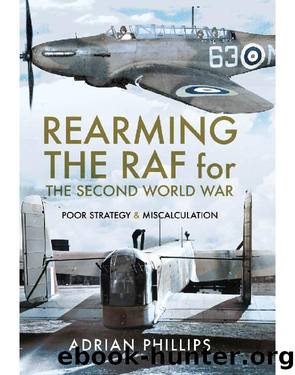Rearming the RAF for the Second World War by Adrian Phillips

Author:Adrian Phillips
Language: eng
Format: epub
Tags: HISTORY / Military / Aviation
Publisher: Pen and Sword History
Published: 2022-08-30T00:00:00+00:00
The apparent general agreement about the potential of RDF masked a rather less harmonious reality. In a newspaper extract from his memoirs that appeared in 1947, Swinton stated that Ellington had opposed building the full-scale chain and that the matter had been referred to a personal discussion between Swinton, Ellington and the prime minister, Stanley Baldwin, who had supported Swinton.14 Ellington wrote to Swinton, complaining that his account was not accurate, although he did not dispute the key assertion that he had been against extending the RDF chain. Ellington claimed to have forgotten whether the question of RDF had been discussed with the prime minister, but scored an effective point by noting that at the time that the Cabinet was asked to approve the expenditure, Chamberlain had already replaced Baldwin as prime minister. Ellington did admit to a degree of scepticism over RDF, writing that he might have questioned whether the âGovernment would feel justified in spending the moneyâ on the stations. He also confessed to doubts as to whether RDF would give information that was timely enough to be useful. He challenged Swintonâs admittedly somewhat garbled account of how RDF had revolutionized fighter tactics with the dubious claim that the only âfundamental advanceâ made before he ceased to be CAS in September 1937 was the introduction of VHF radio. Perhaps conscious that his error over who was the relevant prime minister left him exposed, Swinton removed the entire passage from the published book. This retreat did not deter Swinton from saying long afterwards that Ellington did not support RDF and that he frequently referred to it as âSwintonâs hobbyâ.15
Given the unarguable success of RDF, or radar as it is now universally known, Ellington is unusual in owning up to even a degree of scepticism in the 1930s. The British disclosed its existence in 1941 and since then almost all involved were falling over themselves to claim credit for its invention and introduction. There are scattered indications that Ellingtonâs hostility was widely spread. Bullock, the then head civil servant of the Air Ministry, criticized the heavy focus on developing RDF.16 This might help explain why Swinton did not try to save his official when he was dismissed for a breach of ethics. Joubert de la Ferté, the Air Staffâs RDF specialist, acknowledged later that there were many doubters of RDF in the Air Staff.17
Even when the RDF chain was well on the way to being complete in early 1939, Air Staff was still taking a guarded view of its potential. When the governmentâs air raid precautions supremo, Sir John Anderson, was briefed about the likely scale of German bombing, he was warned that the system would face âteething troublesâ and that RDF could not be expected generally to produce accurate data for some time.18 RDF did not even feature specifically in a detailed assessment drawn up by the Air Staff, released in April 1939, as to the likely shape of an air war with Germany, which claimed that âIn active
Download
This site does not store any files on its server. We only index and link to content provided by other sites. Please contact the content providers to delete copyright contents if any and email us, we'll remove relevant links or contents immediately.
The Radium Girls by Kate Moore(11967)
100 Deadly Skills by Clint Emerson(4875)
Rise and Kill First by Ronen Bergman(4737)
The Templars by Dan Jones(4653)
The Doomsday Machine by Daniel Ellsberg(4446)
The Rape of Nanking by Iris Chang(4165)
Killing England by Bill O'Reilly(3968)
Hitler in Los Angeles by Steven J. Ross(3923)
Stalin by Stephen Kotkin(3916)
12 Strong by Doug Stanton(3525)
Hitler's Monsters by Eric Kurlander(3289)
Blood and Sand by Alex Von Tunzelmann(3164)
The Code Book by Simon Singh(3123)
Darkest Hour by Anthony McCarten(3095)
The Art of War Visualized by Jessica Hagy(2972)
Hitler's Flying Saucers: A Guide to German Flying Discs of the Second World War by Stevens Henry(2729)
Babylon's Ark by Lawrence Anthony(2644)
The Second World Wars by Victor Davis Hanson(2502)
Tobruk by Peter Fitzsimons(2475)
